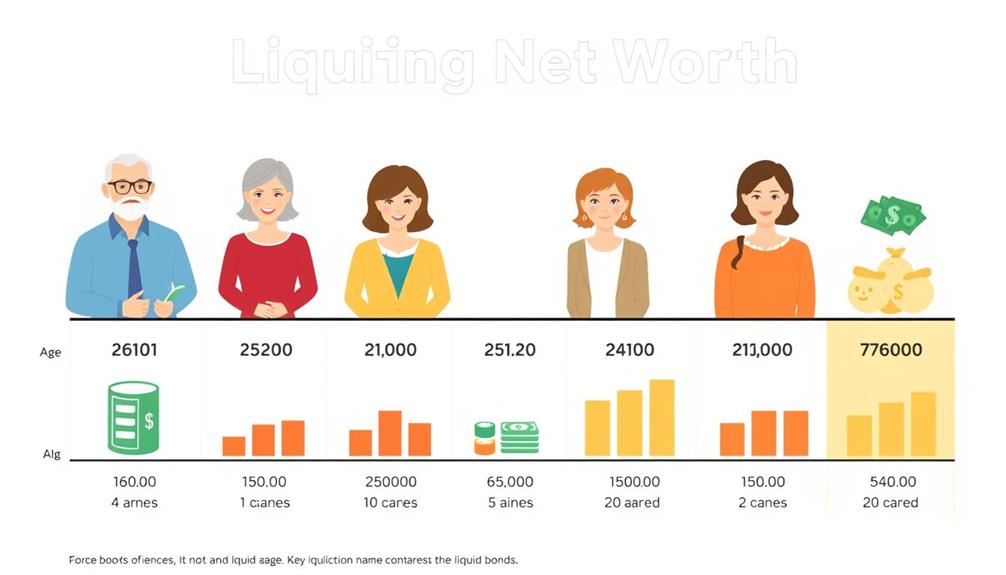Knowing the difference between net worth and liquid assets is essential for your financial health. Your total net worth includes all assets minus liabilities, giving a broad view of wealth. In contrast, liquid assets—like cash and stocks—define the wealth you can access quickly. This distinction reveals your ability to handle emergencies or seize investment opportunities. A high liquid net worth offers financial flexibility, while a lower one might indicate vulnerabilities. By grasping these concepts, you can create a more resilient financial plan. Stick around, and you'll uncover strategies to enhance your liquid net worth and secure your financial future.
Key Takeaways
- Liquid net worth focuses on easily accessible assets, while total net worth includes all assets, liquid and illiquid.
- High liquid net worth provides financial flexibility for emergencies and investment opportunities, impacting overall wealth management.
- Younger households may show positive total net worth but struggle with negative liquid net worth due to debt and limited cash reserves.
- Maintaining a balance of liquid assets is crucial for immediate financial health, as illiquid assets can restrict quick access to funds.
- Understanding both metrics is essential for effective financial planning and assessing true financial stability.
What Is Liquid Net Worth?
Understanding liquid net worth is essential for evaluating your financial health. Liquid net worth is calculated by subtracting your total debts from your liquid assets, which include cash, checking and savings accounts, and easily convertible investments like stocks and bonds.
Unlike total net worth, which includes all assets such as real estate and retirement accounts, liquid net worth focuses solely on the wealth you can quickly access for immediate financial needs. A solid grasp of common financial terms can further enhance your understanding of liquid net worth and its implications.
Having a high liquid net worth is important for your financial stability. It provides a safety net for emergencies and unexpected expenses, allowing you to respond without having to sell non-liquid assets under pressure.
As of 2022, the median liquid net worth for younger households in the U.S. is often negative, while older households tend to have a positive liquid net worth. This trend highlights the significance of age and asset accumulation in your overall financial health.
Maintaining a healthy liquid net worth is critical for making informed financial decisions and capitalizing on investment opportunities, as it reflects your level of accessible wealth at any given moment.
Understanding this concept empowers you to better manage your financial future.
Key Components of Liquid Assets

Liquid assets play an important role in your financial portfolio, as they provide quick access to cash when you need it most. These assets include cash in hand, checking accounts, savings accounts, and cash equivalents like money market accounts. Additionally, publicly traded stocks and bonds fall under the umbrella of liquid assets, as they can be swiftly converted to cash.
Investing in precious metals, such as gold, can also be a part of your liquidity strategy, especially during times of economic uncertainty, as these assets can serve as a hedge against inflation and market volatility investment strategies in precious metals.
In contrast, non-liquid assets, such as real estate or collectibles, can take longer to sell and may not be readily available during emergencies. Understanding these key components is critical for maintaining your financial health and stability.
When calculating liquid net worth, it's important to focus on these easily accessible assets, as they represent your ability to manage expenses without incurring debt. The liquidity of your assets determines how well you can handle unexpected financial needs or seize investment opportunities.
Building a solid foundation of liquid assets is important not only for improving your financial stability but also for ensuring you can navigate any economic challenges that arise. By prioritizing these components, you can enhance your overall financial security.
The Importance of Liquid Net Worth

Maintaining a healthy liquid net worth can make all the difference when unexpected expenses pop up. Your liquid net worth, which is calculated by subtracting total liabilities from your accessible liquid assets, provides a clear snapshot of your financial health. It acts as a vital emergency fund, allowing you to handle unforeseen costs without the hassle of liquidating non-liquid assets, which can take time and lead to losses.
This is especially important when considering best ways to make money online as additional income can help bolster your liquid assets.
Having a high liquid net worth empowers you to seize investment opportunities quickly, offering flexibility during market fluctuations or personal financial crises. You'll find that your ability to act decisively can greatly impact your financial success.
Unfortunately, many younger households in the U.S. report negative liquid net worth, underscoring the need to build accessible savings. By tracking your liquid net worth over time, you can assess your financial preparedness and adjust your spending habits accordingly.
This awareness helps you prioritize effective savings strategies, ensuring you're ready for whatever life throws your way. Ultimately, a strong liquid net worth is essential not just for immediate security, but for long-term financial resilience and growth.
Differences Between Net Worth and Liquid Net Worth

When evaluating your financial situation, it's important to distinguish between net worth and liquid net worth. Net worth is calculated by taking the total value of all your assets minus your total liabilities. This includes everything from property and collectibles to investments.
In contrast, liquid net worth focuses solely on cash and easily convertible assets, such as stocks and bonds, minus liabilities. Understanding the differences between these two metrics can also help in evaluating potential investment opportunities, such as rolling over a retirement account into a Gold IRA, which may offer protection against inflation.
This distinction is essential because your overall net worth may paint an optimistic picture, while your liquid net worth could reveal considerable challenges. For example, many younger households may show positive net worth due to home equity but have negative liquid net worth because of high liabilities.
Understanding these differences can notably impact your financial planning. Liquid net worth provides a clearer view of how quickly you can access cash for emergencies or new investment opportunities.
If you're relying only on your overall net worth, you might overlook critical aspects of your financial health. By evaluating both figures, you can make more informed decisions about your wealth and guarantee you're prepared for any financial situation that arises.
Strategies to Improve Liquid Net Worth

To improve your liquid net worth, building an emergency fund that covers 3-6 months of living expenses is essential for financial security.
Additionally, consider evaluating investment options like Bitcoin IRAs to enhance your overall financial strategy.
Alongside this, reducing high-interest debt is key; it frees up cash flow and enhances your overall financial health.
Emergency Fund Importance
An emergency fund acts as your financial safety net, ensuring you're prepared for unforeseen events like job loss or medical emergencies. Ideally, this fund should cover 3-6 months' worth of living expenses, which greatly boosts your liquid net worth and provides high liquidity. Without it, you might rely on high-interest credit cards during financial crises, which can worsen your situation.
To help you visualize the importance of an emergency fund, consider the following table:
| Emergency Fund Goals | Monthly Savings Target |
|---|---|
| 3 Months of Living Expenses | 15% of Monthly Income |
| 4 Months of Living Expenses | 20% of Monthly Income |
| 5 Months of Living Expenses | 25% of Monthly Income |
| 6 Months of Living Expenses | 30% of Monthly Income |
| Building Financial Confidence | Continuous Savings Growth |
Debt Reduction Strategies
How can you effectively reduce debt to boost your liquid net worth? Implementing smart debt reduction strategies is key to enhancing your financial health. Here are four actionable steps you can take:
1. Pay off high-interest debt: Focus on paying down credit card debt first, as it often carries interest rates over 20%. This will have a significant positive impact on your liquid net worth.
Additionally, consider diversifying your investments with options like precious metal investments to further secure your financial future.
2. Use the debt snowball method: Consider paying off your smallest debts first to gain momentum, or opt for the avalanche method to tackle the highest interest debts. Choose what motivates you most.
3. Maintain a healthy debt-to-income ratio: Aim to keep this ratio below 36%. Lenders often use it to assess your borrowing capacity, so it's essential for your financial stability.
4. Create a budget: Allocate at least 20% of your income towards savings and debt repayment.
Regularly track your expenses to uncover areas for potential savings, allowing you to funnel more money into debt reduction.
Understanding the Role of Liquid Assets

Liquid assets often play an essential role in your financial well-being, providing quick access to funds when you need them most. These assets include cash and assets that can be swiftly converted into cash, such as checking and savings accounts, stocks, and bonds.
By maintaining a healthy balance of liquid assets, you enhance your liquid net worth, which is fundamental for achieving financial stability. Additionally, incorporating alternative investments like Gold IRAs can further diversify your portfolio, adding a layer of protection against market volatility.
Many people find themselves with a significant portion of their wealth tied up in illiquid assets like real estate. This can limit your overall liquidity and flexibility when facing unexpected expenses.
In contrast, having liquid assets allows you to cover daily expenses or emergencies without the hassle of selling off non-liquid assets, which can take time and may result in losses due to market fluctuations.
A solid financial strategy should prioritize building your liquid assets, including creating an emergency fund that covers 3-6 months of living expenses.
This preparedness not only provides peace of mind but also strengthens your financial resilience in times of need, ensuring that you can respond effectively to life's uncertainties.
Typical Liquid Net Worth by Age

When you look at liquid net worth by age, you'll notice some interesting trends.
Young households often struggle with negative net worth due to student debt, while middle-aged individuals see a gradual increase as their careers progress.
It's important to contemplate the financial implications of long-term care, as understanding assisted living expenses can markedly affect one's liquid net worth.
As you approach retirement, your liquid assets typically grow, reflecting years of saving and financial planning.
Young Households' Liquid Trends
What drives the stark differences in liquid net worth among young households today? The financial landscape for those aged 25-34 is challenging, with many facing a negative median liquid net worth of around -$1,500. This situation is compounded by the emotional instability often experienced in their relationships, as those with Borderline Personality Disorder (BPD) may struggle with financial decision-making due to impulsive behaviors.
Here are some key factors contributing to this trend:
- Student Debt: Many young adults carry significant student loans, impacting their financial health.
- Limited Cash Reserves: Young households often struggle to accumulate accessible liquid assets.
- High Living Costs: Rising expenses for housing and essentials leave little room for savings.
- Employment Instability: Many are maneuvering uncertain job markets, hindering their ability to build wealth.
As a result, young households typically rely more on home equity, while older households boast better immediate financial liquidity with a median liquid net worth of approximately $25,000 for those aged 55-64.
Despite the median household net worth in the U.S. reaching $192,700 in 2022, the distribution of liquid assets shows that young households are grappling with significant financial challenges. Understanding these dynamics is essential for managing your financial journey effectively.
Middle-Aged Wealth Patterns
Middle-aged adults often experience a notable shift in their financial landscape, marked by an increase in liquid net worth. As you reach your 40s and 50s, your financial stability typically improves, thanks to established careers and higher earnings. Understanding the financial implications of divorce can also play an important role in shaping your liquid assets during this time.
Your liquid assets include cash, savings, and investments, which grow as you prioritize financial planning and make strategic decisions. During this phase, it's vital to decrease your liabilities, especially by paying down high-interest debts. Many individuals focus on building emergency funds, ensuring they've a safety net for unexpected expenses.
This approach not only boosts your liquid net worth but also contributes to long-term financial health. As you approach retirement, balancing liquid and illiquid assets becomes important. By effectively managing these assets, you can secure your financial future and enhance your overall net worth over time.
Aim to allocate funds towards retirement assets, which will support you in your later years. Remember, the choices you make now can greatly impact your wealth trajectory, so stay proactive in your financial planning and maintain a healthy liquid net worth.
Retirees' Liquid Assets Insights
As you move into retirement, understanding the dynamics of liquid assets becomes increasingly essential. Your financial stability hinges on having accessible funds to cover living expenses and unexpected healthcare costs.
Here are some key insights on typical liquid net worth by age:
- Ages 55-64: The median liquid net worth is approximately $75,000, reflecting the gradual increase in savings as you approach retirement.
- Ages 65 and above: Older households typically exhibit a markedly higher liquid net worth, showcasing the importance of liquid assets in their financial planning.
- Healthcare Expenses: As you age, prioritizing liquidity helps guarantee you can manage healthcare expenses without financial strain.
- Investments: Many retirees rely on liquid assets like savings accounts and investments to maintain their lifestyle and meet their financial goals.
Understanding your liquid net worth is vital; it not only provides insight into your financial health but also allows you to navigate retirement with confidence.
How to Calculate Liquid Net Worth

Calculating your liquid net worth is a straightforward process that can provide valuable insights into your financial situation. To begin, you'll need to identify your total liquid assets, which include cash, checking accounts, savings accounts, stocks, bonds, and other quickly convertible investments.
Once you have this figure, you can move on to your total liabilities, which are any debts or obligations you owe.
The formula is simple: liquid net worth = total liquid assets – total liabilities. For example, if your liquid assets total $116,000 and your liabilities amount to $112,000, your liquid net worth would be $4,000.
This calculation excludes non-liquid assets like real estate and retirement accounts, giving you a clearer picture of your immediate financial health and cash accessibility.
It's crucial to understand how liquid net worth differs from total net worth, as the focus here is on assets that can be accessed quickly.
Limitations of Liquid Net Worth

While understanding liquid net worth can help you assess your immediate financial situation, it's important to recognize its limitations. Here are four key points to evaluate:
- Exclusion of Illiquid Assets: Liquid net worth doesn't account for valuable assets like real estate that contribute to your total net worth.
- Potential Misleading Impression: Focusing solely on liquid net worth can misrepresent your financial health, especially if you have significant wealth tied up in illiquid assets.
- Market Conditions Impact: Your liquid net worth can fluctuate based on market conditions, affecting your perceived financial stability at any moment.
- Emergency Preparedness: Relying only on liquid assets may leave you unprepared for emergencies, requiring access to a broader range of financial resources.
Conclusion
In the grand tapestry of wealth, understanding the difference between net worth and liquid net worth is your golden thread. While your total net worth paints a broad picture, liquid net worth reveals the vibrant details that can sustain you in tough times. By focusing on your liquid assets, you can secure your financial future and navigate life's uncertainties with confidence. So, take charge—boost your liquid net worth and watch your financial freedom flourish!










